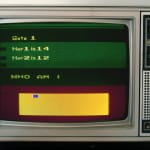Yucef Merhi Venezuelan, b. 1977
Atari Ex Machina, 2007
Atari 2600, cartridge, keyboard, CRT TV
72 x 24 x 24 in. / 182.9 x 61 x 61 cm
Copyright The Artist
Photo: The Artist
Atari Ex Machina examines the origin of language and consciousness by means of simple programming iterations. Like bin@ari (1985), this is a computerized video rendered on real-time using an Atari...
Atari Ex Machina examines the origin of language and consciousness by means of simple programming iterations. Like bin@ari (1985), this is a computerized video rendered on real-time using an Atari 2600.
The screen is composed of four interlaced rows. On the first row the viewer can see the continuous emergence of programming instructions. The second row contains the name and location of the two main characters, HOR1 and HOR2. The third row displays the sentence 'WHO AM I,' but only when the characters of the video run over each other. Finally, all the data is compiled and visualized on the fourth row. This is presented as two rectangles (HOR1 and HOR2) that randomly move on a large background rectangle.
The relationship between consciousness and language has been widely explored by numerous philosophers, including Husserl, Wittengstein, Heidegger, Merlau-Ponty, and Derrida, among others. One of the main questions related to this subject is: does consciousness precede language or is it language that precedes consciousness? There are several theories that sustain either of both views. Another assumption is that consciousness emerged in tandem with the human acquisition of the capacity for language. In the book The Story of My Life and The World I Live In, written by Helen Keller, and first published in 1903, she comments, “When I learned the meaning of 'I' and 'me' and found that I was something, I began to think. Then consciousness first existed for me.”
In Atari Ex Machina Merhi sets a parallel between humans and machines. The work depicts how through (programming) language the machine acquires (simulated) consciousness because of the (programmed) social interactions between both rectangles. As a result, the same question is printed on the screen once and again: WHO AM I.
Even so, who is asking? The computer characters or the programming instructions? The Atari or the human being that programmed the Atari? The human consciousness or the language that comes before? The artist or the viewer who reads and thinks about this sentence?
The screen is composed of four interlaced rows. On the first row the viewer can see the continuous emergence of programming instructions. The second row contains the name and location of the two main characters, HOR1 and HOR2. The third row displays the sentence 'WHO AM I,' but only when the characters of the video run over each other. Finally, all the data is compiled and visualized on the fourth row. This is presented as two rectangles (HOR1 and HOR2) that randomly move on a large background rectangle.
The relationship between consciousness and language has been widely explored by numerous philosophers, including Husserl, Wittengstein, Heidegger, Merlau-Ponty, and Derrida, among others. One of the main questions related to this subject is: does consciousness precede language or is it language that precedes consciousness? There are several theories that sustain either of both views. Another assumption is that consciousness emerged in tandem with the human acquisition of the capacity for language. In the book The Story of My Life and The World I Live In, written by Helen Keller, and first published in 1903, she comments, “When I learned the meaning of 'I' and 'me' and found that I was something, I began to think. Then consciousness first existed for me.”
In Atari Ex Machina Merhi sets a parallel between humans and machines. The work depicts how through (programming) language the machine acquires (simulated) consciousness because of the (programmed) social interactions between both rectangles. As a result, the same question is printed on the screen once and again: WHO AM I.
Even so, who is asking? The computer characters or the programming instructions? The Atari or the human being that programmed the Atari? The human consciousness or the language that comes before? The artist or the viewer who reads and thinks about this sentence?



